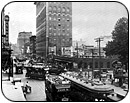| home | our mission | contact us | issue archive |

Jul 2002 / communities :: email this story to a friend

The View from Stockton House
By Frederick D. MedlerAs of this past March, I have lived in the Grand Center / Midtown neighborhood for 24 years. During this time, in which I have grown from a young man in my twenties to a more mature and wise "mid-lifer," I have witnessed many changes in my beloved neighborhood. I must confess, most of these changes and "improvements" initiated via the various Grand Center Redevelopment incarnations have, in my opinion, not been for the better. Allow me to explain my unique perspective.
When I first moved here to undertake the restoration of my historic home, the Robert Henry Stockton House, the neighborhood was far from being a desirable address. Many people considered me crazy to consider such an area for my residence. After moving back from Seattle, where I worked in architectural design and urban redevelopment, I was seriously anxious to undertake a historic rehab of my own, and to in turn experience our truly great heritage of architecture and craftsmanship first hand, something of which residents of most West Coast cities can only dream.
The lady from whom I purchased Stockton House was elderly and frail and could no longer deal with the responsibility of owning an aging home of such a grand scale. Abandoned, overgrown in weeds, and repeatedly vandalized, it stood on its "last legs." Yet despite the problems I faced, and I do not believe any young person can fully comprehend such a Herculean task outright, the activities and atmosphere of such a unique and rare urban area excited me greatly.
click to enlarge Within just a three-block area of my home, I found myself able to provide for nearly all of my needs without driving my car. Food stores, fruit markets, a shoeshine parlor, a jewelry store, a book and magazine shop, a Walgreen's drug store, and a Woolworth's department store were all within easy walking distance. In addition, there were numerous restaurants, taverns and nightclubs where I could hang out. For those looking for an occasional fling on the wild side, three gay bars, a fabulous old billiard hall, and numerous porno shops were all a short walk down Olive Street.
My life started to develop a wonderful and settled routine. Nearly every morning, I would take breakfast at the restaurant at Walgreen's, reading the Globe Democrat. Afternoons found me at the famous old Garavelli's on Olive for a late lunch and stimulating conversation and debate with professors and students from Saint Louis University.
True, the area was run down and it did have more than its share of weed-filled lots and abandoned buildings, but most of the buildings were fully occupied, and many people lived here, loved it, and cared. Everyone wanted the area to be improved and cleaned up, but none of us expected what was to follow.
In late 1980, City Center Redevelopment Corporation was formed to take over from the defunct earlier effort, Midtown St. Louis, Inc., to try again to redevelop the area. Under the leadership of Mr. Geoffrey Simril, the agency began to promote the area and a positive spirit seemed to permeate the air. City Center began to by up properties, lots were cleared of debris, some buildings were razed, and events were sponsored to bring people back into the area.
In 1981, the renovation of the Fox Theatre, under the leadership and vision of Leon and Mary Strauss, commenced. Although this was a very beneficial development for the area, an unexpected side effect occurred which was no doubt unforeseen, but nonetheless killed a good part of the neighborhood in the process. With the restoration and reopening of the Fox Theatre, a new performance venue, surrounding land was purchased and paved over for new surface parking. Such a grand facility naturally required a great deal of parking and as one walks the area today, surface lots stretch for blocks in every direction.
Two things resulted from this: first, the sudden change of the area from an urban environment into a sea of asphalt effectively reduced the attractiveness as an "urban destination." Only people coming and going from concert venues would appreciate the parking convenience. The area dramatically lost its appeal as an urban space to walk or saunter through. Who wants to walk amidst sun-baked asphalt parking lots?
Second, with so many automobiles coming to events at the Fox during both the days and evenings, available street parking for the multitude of small shops and businesses all but completely dried up. For persons to come into the area to visit a drug store, tavern, bookstore, etc. became a ridiculous hassle. Who would want to pay to park just to go to a drug store or to Woolworth's?
By 1986, City Center reincarnated into Grand Center, Inc. to serve an area that was essentially by then a ghost town when concert events were not happening. It was at this time that an ongoing process of demolition began to make the area "more attractive for developers."
During the past fifteen years, many good things have happened here in Grand Center. The Grandel Square Theatre is a jewel to behold. The restored Sheldon Arts Center, the Pulitzer Gallery, City House, as well as a few other arts facilities have been built. However, what has not happened is the development of a lively urban neighborhood similar to the University City "Loop." What has happened is this: the development of an urban version of Earth City — a vast sea of parking lots decorated with landscaping. The area is dead, excepting when concert events transpire. The few people who walk the streets are those riding buses or those panhandling for change. No longer do shops and lively social interaction exist here.
Hopefully Vince Schoemel, Grand Center's new head, will have the vision and leadership to bring Grand Center into the future as a more cohesive entity. Our arts venues here in Grand Center are truly important to this area, and more specifically to the city, but there is a great need for a more comprehensive inclusion of other commercial activities and residential uses if this area is to flourish in a sustainable way. And as much as it is important to build many new facilities, preserving what little is left of our history, as a link to days gone by, is critical to the survival of the urban fabric. I have witnessed far too much of this area pulled down without any thought or vision of the larger whole. Finally, let me say that many of the problems that have occurred here were no doubt unexpected. There has been much good will and sincere thought involved in the slow rebuilding of the area, and I only hope that we continue to learn from our mistakes and unite to build both a better neighborhood and a more livable and beautiful city.
Church and State | Games | Expatriates | Communities | From the Source
It's All Happening | Young Minds | The Ordinary Eye | Elsewhere
Sights and Sounds | Media Shoegaze | A Day's Work | From the Editor
© 2002 The Commonspace

